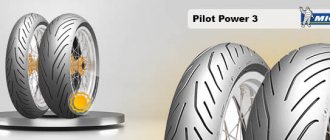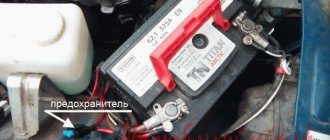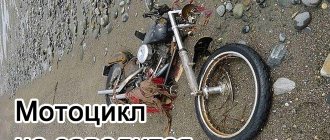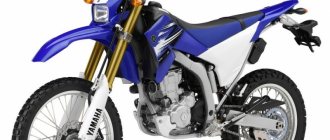MY MOTORCYCLE
Caring for your “iron horse” requires a lot of responsibility, because mistakes when installing equipment on a vehicle can be very expensive. Tires on a motorcycle are one of the most important elements, because contact with the road and the bike is ensured by only two small zones.
Correct installation and operation of tires will not only ensure an adequate level of safety, but will also allow you to save on vehicle repairs and the frequency of component replacement.
If you feel sufficiently confident in your abilities and are ready to replace the tires yourself without going to a tire shop, here are the basic rules for this procedure.
Removal/installation
To get started, stock up on the necessary tools:
• silicone grease in aerosol packaging;
• flat tool for tire mounting;
• device for beading;
• nozzle for holding the nipple open;
Are the equipment and tires on the motorcycle ready for installation? Let's get started.
Removal:
1. Using the special valve tool to hold it open, bleed the air from the tire.
2. Inserting a special dismantling tool between the tire and the wheel rim, remove the tire, starting from the inside. A loud bang will indicate that the tire has been removed from the rim. Don't stop at this achievement and continue to carefully pry the tire off the rim on both sides.
3. To make the removal process easier, the edges of the tire can be lubricated with silicone grease.
Installing a new tire:
1. Apply lubricant to the inner surface of the tire.
2. Following the instructions regarding the direction of rotation, position the tire so that the special mark in the form of a dot is opposite the valve.
3. Using a pry bar, place the tire on the wheel rim.
4. Inflate the tire a little, but not completely.
5. Using a mounting spatula, shrink the edge of the tire onto the rim.
6. Inflate the tire to the recommended pressure level.
Now all that remains is to ensure proper care of your tires so that they last as long as possible.
Caring for motorcycle tires
First of all, in order to maintain the high properties of the material, motorcycle rubber should not be exposed to direct sunlight, acid rain or aggressive mechanical influences.
The owner of a motorcycle must regularly perform the following actions:
• inspect tires for damage and excessive wear - for motorcycle tires, a tread depth of 0.8 mm is considered critical;
• monitor internal pressure using a pressure gauge and adjust it in a timely manner.
Proper seasonal storage of tires is of no small importance. First of all, motorcycle tires must be thoroughly cleaned of dirt and stones. For storage, you must choose a closed room with an air temperature of 20 to 25 ° C. Tires should never be stored outdoors. Rubber products must be protected from sparks, acids and fuels and lubricants. Otherwise, chemical reagents can cause irreparable damage to tires.
Source
What tools may be useful in the process?
Various tools are used to remove a tire from a wheel, including:
- a set of plastic mounting blades - made of durable material and allow you to work with rubber products without damaging them;
- a set of metal tire pry bars - they come in different types (straight, s-shaped, l-shaped), they are tools of different types of impact - impact or lever;
- various tire pliers;
- a set of keys;
- hammers and sledgehammers.
Replacing tires on a motorcycle with your own hands.
Owners of motorcycles with rims are forced to go to a tire shop to install new tires on their motorcycle. When replacing tires on such motorcycles with your own hands, the disc may bend and lose its presentation. On the other hand, if you have an enduro or any other motorcycle with spoked wheels, you can easily change the tires yourself. Moreover, any normal endurist simply must be able to change tires in the field with the help of a pair of tire bars, since off-road trips often involve long runs on asphalt. In this case, it is advisable to go to the place of drowning in the mud on road tires, take a set of “evil” tires with you and put them on the motorcycle in an open field immediately before the off-road. Today we will talk about changing the tires of a motorcycle with spoked wheels yourself.
We will also talk about the types of motorcycle tires and indices in the names of rubber models, since this topic is worthy of a separate article, and maybe more than one. Today, within the framework of this article, I will give only one very simple classification. Motorcycle tires come in tubed and tubeless varieties. Tubeless tires are comfortable and are widely used on motorcycles with disc wheels. The disc is sealed inside, so all you have to do is install new tires, coat the joints with a special sealant, inflate them, and you’re good to go. Spoke wheels are not sealed internally because one end of the spokes goes right through the wheel rim. Spoke wheels use tires with inner tubes - it’s clear why.
Is it possible to install tubeless tires on a spoked motorcycle wheel by simply sticking a regular tube inside? Yes, easily! Now I will just install tubeless tires with cameras on my motorcycle.
What, then, is the difference between tubed and tubeless tires? Everything is very simple. Tubeless rubber has a special groove on the inside, it acts like a “hook” and increases the tightness.
Differences in tire types
The very first replacement of tires on a motorcycle or scooter gives reason to think - what is better in terms of quick repairs: tubeless tires that do not require disassembling the wheel to eliminate a puncture, but leave the rider helpless if, along with the damage, the edge of the disc “leads” and flattens? Or tubes that allow almost circular holes to be repaired (as long as there are enough patches), but require removal of the rubber from the rim for this? There is no clear answer. Few classics, street or tourers today remain “faithful” to tube rubber models: tubeless tires are lighter, softer, warm up and cool down faster due to simplified heat transfer. In sports, more precisely, enduro and motocross, tube wheels, on the contrary, prevail: only spoked wheels can “play”, withstanding strong alternating loads during landings and impacts.
The nuance is that a tire with a tube can be placed on any rim, spoked or cast, but a tubeless tire can only be placed on a cast rim, because only it can ensure tightness. Tube – can be installed in a tubeless tire as an emergency measure. In case of major damage to the sidewall, cracks or curvature of the edges of the rim, this will make it possible to inflate the wheel and make it to the nearest tire shop (and there will be straightening, balancing and other maintenance according to the rules). True, for such a trick it is advisable to take a camera with a nominal value one less than the diameter of the disk, otherwise it will create folds inside that will wear out over a couple of hundred kilometers. The resource of such “treatment” is large - until the next puncture, like a new one.
Replacing tires on a motorcycle with your own hands.
What you need to change tires on a motorcycle yourself. To replace tires on a motorcycle, we will need the following materials and tools: 1) New tires. In my case, the BMW F650GS motorcycle is a Metzeller Tourance. The official Metzeller website defaults to the tire sizes specified in the manual for the BMW F650GS motorcycle. Front - 110/90 - R19, rear - 130/80 R17. In principle, there is a lot of space left in the front and rear, so I will put a 120/90 with a 19 radius on the front wheel, and leave everything as it should be in the rear. 2) Mounts (or mounts, whatever you call them). I can cope alone, but I have experience starting from Java. It's better to use two. 3) Soap solution. It will be needed when putting on new tires, and it can also come in handy when removing old ones. Without it, you can accidentally tear the tire. I know many people use Vaseline and other neutral lubricants. I don’t even know where to buy Vaseline now, so I use a soap solution. Soap in water should ideally not dissolve completely and be similar in consistency to snot









